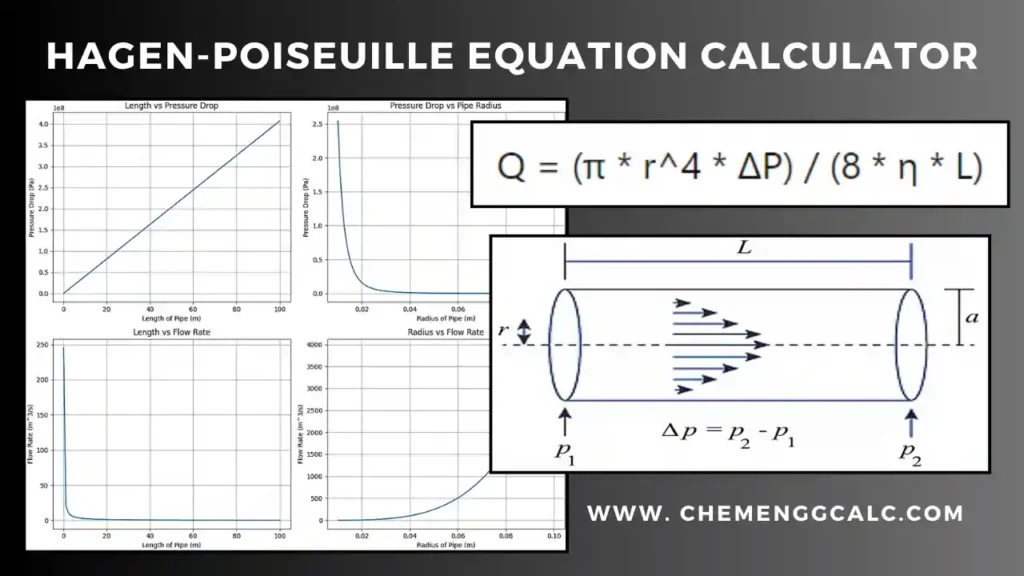Table of Contents
What is Schmidt Number?
The Schmidt number \((Sc)\) is a dimensionless number named after German engineer Ernst Heinrich Wilhelm Schmidt. It is defined as the ratio of momentum diffusivity (kinematic viscosity) and mass diffusivity. This number gives the relationship between Kinematic viscosity and mass diffusivity of the fluid.
Mathematically, it is defined as:
\[Sc = \frac{\text{momentum diffusivity}}{\text{mass diffusivity}} \]
\[ \mathrm{Sc} = \frac{\nu}{D} = \frac{\mu}{\rho D}\]
where (in SI units):
- \( \nu = \frac{\mu}{\rho}\) is the kinematic viscosity (\({m^2/s}\))
- \( D\) is the mass diffusivity (\({m^2/s}\))
- \(\mu\) is the dynamic viscosity (N·s/m²)
- \(\rho\) is the density (Kg/m3)
Note: The heat transfer analogy of the Schmidt number is the Prandtl number (Pr).
Related: Fick’s First Law of Diffusion Calculator – Molecular Diffusion
Schmidt Number Calculator
This calculator is helpful to calculate parameters like \(Sc\) Number, mass diffusivity (\(D\)), dynamic viscosity (\(\mu\)) or density (\(\rho\)) based on the formula \(\mathrm{Sc} = \frac{\mu}{\rho D}\). This tool is useful for engineers and scientists working in fields involving mass transfer and fluid dynamics.
Related: Fick’s Second Law of Diffusion – Concept and Calculation
Schmidt Number Significance
The Schmidt number is significant in Mass Transfer provides a measure of the relative rates of momentum and mass transport by diffusion in a fluid.
– Flow Characteristics
- The Schmidt number helps predict the behavior of flow and diffusion in different fluid systems.
- A high \(Sc\) number shows that momentum diffusivity dominates over mass diffusivity, which means the fluid’s viscosity significantly influences flow characteristics.
- A low \(Sc\) number means that mass diffusivity is more dominant, leading to more effective mixing and mass transfer.
– Boundary Layer Characteristics
- This number describe the thickness of the concentration boundary layer relative to the velocity boundary layer.
- A high Schmidt number means a thinner concentration boundary layer compared to the velocity boundary layer, affecting the overall mass transfer rate at the boundary.
Other Dimensionless Numbers
Here we have tabulated the list of dimensionless numbers which are commonly used in Chemical Engineering with their formula, definition, and significance.
| Dimensionless Number | Formula | Definition | Significance |
|---|---|---|---|
| Reynolds Number (Re) | \[\text{Re} = \frac{\rho u L}{\mu} = \frac{u L}{\nu}\] | Ratio of inertial forces to viscous forces. | Determines flow regime: Re < 2000: Laminar flow Re > 4000: Turbulent flow. Critical for pipe flow and reactors. |
| Prandtl Number (Pr) | \[\text{Pr} = \frac{C_p \mu}{k}\] | Ratio of momentum diffusivity to thermal diffusivity. | It indicates the relative thickness of momentum and thermal boundary layers in heat transfer. |
| Nusselt Number (Nu) | \[\text{Nu} = \frac{h L}{k}\] | Ratio of convective to conductive heat transfer. | It is used in convective heat transfer problems to evaluate heat transfer coefficients. |
| Sherwood Number (Sh) | \[\text{Sh} = \frac{k_m L}{D}\] | Ratio of convective to diffusive mass transfer. | It is important in mass transfer, especially in diffusion and absorption processes. |
| Péclet Number (Pe) | \[\text{Pe} = \text{Re} \cdot \text{Pr}\] | Ratio of advection to diffusion. Combines Reynolds and Prandtl numbers. | It is important in heat and mass transfer processes where advection dominates over diffusion. |
| Schmidt Number (Sc) | \[\text{Sc} = \frac{\mu}{\rho D}\] | Ratio of momentum diffusivity to mass diffusivity. | It is used in mass transfer to relate momentum and mass transport. Analogous to the Prandtl number in heat transfer. |
| Lewis Number (Le) | \[\text{Le} = \frac{\alpha}{D} = \frac{\text{Sc}}{\text{Pr}}\] | Ratio of thermal diffusivity to mass diffusivity. | It relates thermal and mass transport; Le = 1 implies similar thermal and mass diffusivity. |
| Fourier Number (Fo) | \[\text{Fo} = \frac{\alpha t}{L^2}\] | Ratio of heat conduction rate to heat storage rate. | It is used in unsteady-state heat transfer problems, like transient conduction. |
| Biot Number (Bi) | \[\text{Bi} = \frac{h L}{k}\] | Ratio of internal thermal resistance to surface thermal resistance. | It determines whether heat conduction is lumped or distributed. Bi < 0.1: Lumped system approximation valid. |
| Weber Number (We) | \[\text{We} = \frac{\rho u^2 L}{\sigma}\] | Ratio of inertial forces to surface tension forces. | It is important in multiphase flows, droplet formation, and fluid interface stability. |
| Capillary Number (Ca) | \[\text{Ca} = \frac{\mu u}{\sigma}\] | Ratio of viscous forces to surface tension forces. | It is used to study the behavior of capillary flows and thin-film phenomena. |
| Froude Number (Fr) | \[\text{Fr} = \frac{u^2}{g L}\] | Ratio of inertial forces to gravitational forces. | It is important in free-surface flows, mixing, and fluidized bed design. |
| Damköhler Number (Da) | \[\text{Da} = \frac{\text{Reaction rate}}{\text{Flow rate}}\] | Ratio of chemical reaction time to residence time. | It is important in chemical reaction engineering; determines if a process is reaction- or transport-limited. |
| Thiele Modulus (ϕ) | \[\phi = L \sqrt{\frac{k}{D}}\] | Ratio of reaction rate to diffusion rate within a catalyst particle. | It is used in heterogeneous catalysis to determine diffusion limitations within catalyst pores. |
| Knudsen Number (Kn) | \[\text{Kn} = \frac{\lambda}{L}\] | Ratio of molecular mean free path to characteristic length. | It is important in gas flow through small pores or microchannels; indicates continuum vs. molecular flow regime. |
| Eckert Number (Ec) | \[\text{Ec} = \frac{u^2}{C_p \Delta T}\] | Ratio of kinetic energy to enthalpy difference. | It is used in high-speed flows and heat transfer problems involving viscous dissipation. |
| Grashof Number (Gr) | \[\text{Gr} = \frac{g \beta \Delta T L^3}{\nu^2}\] | Ratio of buoyancy forces to viscous forces. | It determines the importance of natural convection in heat transfer problems. |
| Stanton Number (St) | \[\text{St} = \frac{h}{\rho u C_p}\] | Ratio of heat transfer coefficient to the product of fluid velocity and specific heat. | It is used in heat transfer to describe convective heat transfer efficiency relative to bulk flow. |
Related: 10 Mostly used Dimensionless Numbers in Chemical Engineering
Python Code for Schmidt Number
This Python code calculates the Schmidt number (Sc) for a range of value and generates a contour plot to visualize how the Schmidt number varies with changes in kinematic viscosity and mass diffusivity. This code is helpful in analysis of fluid flows involving simultaneous momentum and mass transfer by diffusion.
Note: This Python code solves the specified problem. Users can copy the code and run it in a suitable Python environment. By adjusting the input parameters, and observe how the output changes accordingly.
import numpy as np
import matplotlib.pyplot as plt
# Sample values for kinematic viscosity and mass diffusivity
kinematic_viscosity = np.linspace(1e-7, 1e-4, 100) # in m²/s
mass_diffusivity = np.linspace(1e-9, 1e-6, 100) # in m²/s
# Create a meshgrid for plotting
X, Y = np.meshgrid(kinematic_viscosity, mass_diffusivity)
# Calculate the Schmidt_number
Schmidt_number = X / Y
# Plotting the Schmidt_number
plt.figure(figsize=(10, 6))
contour = plt.contourf(X, Y, Schmidt_number, levels=50, cmap='viridis')
cbar = plt.colorbar(contour)
cbar.set_label('Schmidt Number (Sc)')
plt.xlabel('Kinematic Viscosity (m²/s)')
plt.ylabel('Mass Diffusivity (m²/s)')
plt.title('Schmidt Number (Sc) Contour Plot')
plt.xscale('log')
plt.yscale('log')
plt.show()Output:

Resources
- “Transport Phenomena” by R. Byron Bird, Warren E. Stewart, and Edwin N. Lightfoot.
- “Introduction to Chemical Engineering Thermodynamics” by J.M. Smith, H.C. Van Ness, and M.M. Abbott.
- “Mass Transfer Operations” by Robert E. Treybal.
Disclaimer: The Solver provided here is for educational purposes. While efforts ensure accuracy, results may not always reflect real-world scenarios. Verify results with other sources and consult professionals for critical applications. Contact us for any suggestions or corrections.






